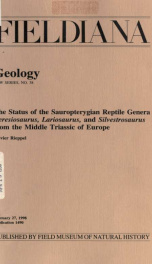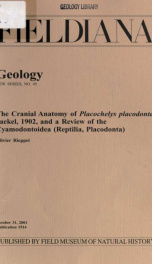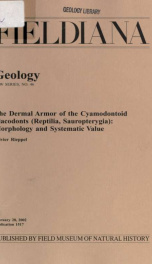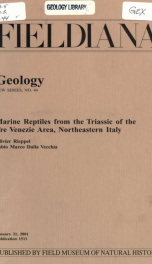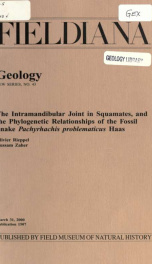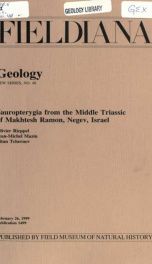Placodus gigas Agassiz, 1833, from the Muschelkalk of the Germanic Triassic, is recognized as the only valid species of its genus. Placodus gracilis Jurcsak, 1976 (pending a revision of the original material), and Placodus impressus Agassiz, 1833, are considered nomina dubia. An amended diagnosis based on homologies (synapomorphies) is provided for the genus Placodus and its only known species. The skeletal structure of Placodus is described, and the phylogenetic interrelationships of the genus are discussed. Placodonts originated along the northern coast of the Tethys, and early during their phylogeny split into two lineages, the Placodontoidea and Cyamodontoidea. Placodus immigrated into the Muschelkalk Basin through an eastern seaway (possibly the Silesian-Moravian Gate) during early Anisian time Includes bibliographical references (p. 39-42) Placodus gigas Agassiz, 1833, from the Muschelkalk of the Germanic Triassic, is recognized as the only valid species of its genus. Placodus gracilis Jurcsak, 1976 (pending a revision of the original material), and Placodus impressus Agassiz, 1833, are considered nomina dubia. An amended diagnosis based on homologies (synapomorphies) is provided for the genus Placodus and its only known species. The skeletal structure of Placodus is described, and the phylogenetic interrelationships of the genus are discussed. Placodonts originated along the northern coast of the Tethys, and early during their phylogeny split into two lineages, the Placodontoidea and Cyamodontoidea. Placodus immigrated into the Muschelkalk Basin through an eastern seaway (possibly the Silesian-Moravian Gate) during early Anisian time Fieldiana series has been published as Geological Series by Field Columbian Museum (1895-1909) and Field Museum of Natural History (1909-1943), and as Fieldiana: Geology by Chicago Natural History Museum (1945-1966) and Field Museum of Natural History (1966-1978). Fieldiana Geology New Series No. 1 began June 29, 1979





